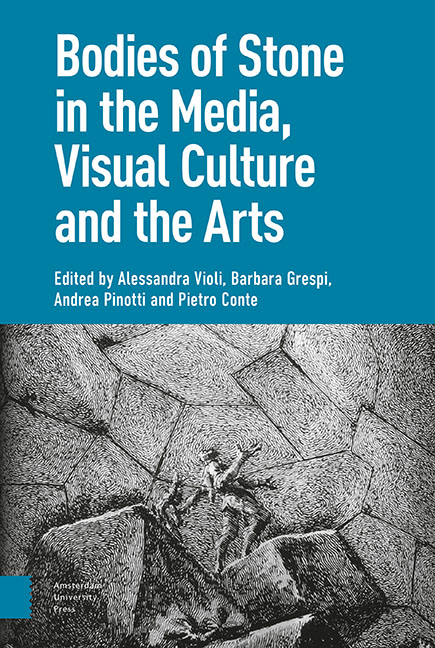Book contents
- Frontmatter
- Contents
- Introduction: Learning from Stone
- I Statue: The Imaginary of Uncertain Petrification
- 1 Theatre and Memory: The Body-as-Statue in Early Modern Culture
- 2 Translated Bodies: A ‘Cartographic’ Approach
- 3 Pantomime in Stone: Performance of the Pose and Animal Camouflage
- 4 Animated Statues and Petrified Bodies: A Journey Inside Fantasy Cinema
- 5 The Ephemeral Cathedral: Bodies of Stone and Configurations of Film
- II Matter: Size, Hardness, Duration
- 1 Bodies That Matter: Miniaturisation and the Origin(s) of ‘Art’
- 2 Brancusi’s ‘Sculpture for the Blind’
- 3 Cinema, Phenomenology and Hyperrealism
- 4 Ephemeral Bodies: The ‘Candles’ of Urs Fischer
- 5 The Celluloid and the Death Mask: Bazin’s and Eisenstein’s Image Anthropology
- III Corpse: Fossils, Auto-Icons, Revenants
- 1 Funeral Eulogy: Post-Mortem Figures and Redeemed Bodies, in Images
- 2 On Jack Torrance As a Fossil Form
- 3 Technical Images and the Transformation of Matter in Eighteenth-Century Tuscany
- 4 Glass, Mixed Media, Stone: The Bodily Stuffs of Suspended Animation
- 5 Bodies’ Strange Stories: Les Revenants and The Leftovers
- IV Monument: Embodying and Grafting
- 1 The Impassibly Fleshly, the Statue of the Impossible
- 2 Frozen into Allegory: Cleopatra’s Cultural Survival
- 3 The Orphan Image
- 4 The Well-Tempered Memorial: Abstraction, Anthropomorphism, Embodiment
- 5 Monuments of the Heart: Living Tombs and Organic Memories in Contemporary Culture
- Index
2 - Translated Bodies: A ‘Cartographic’ Approach
Published online by Cambridge University Press: 20 November 2020
- Frontmatter
- Contents
- Introduction: Learning from Stone
- I Statue: The Imaginary of Uncertain Petrification
- 1 Theatre and Memory: The Body-as-Statue in Early Modern Culture
- 2 Translated Bodies: A ‘Cartographic’ Approach
- 3 Pantomime in Stone: Performance of the Pose and Animal Camouflage
- 4 Animated Statues and Petrified Bodies: A Journey Inside Fantasy Cinema
- 5 The Ephemeral Cathedral: Bodies of Stone and Configurations of Film
- II Matter: Size, Hardness, Duration
- 1 Bodies That Matter: Miniaturisation and the Origin(s) of ‘Art’
- 2 Brancusi’s ‘Sculpture for the Blind’
- 3 Cinema, Phenomenology and Hyperrealism
- 4 Ephemeral Bodies: The ‘Candles’ of Urs Fischer
- 5 The Celluloid and the Death Mask: Bazin’s and Eisenstein’s Image Anthropology
- III Corpse: Fossils, Auto-Icons, Revenants
- 1 Funeral Eulogy: Post-Mortem Figures and Redeemed Bodies, in Images
- 2 On Jack Torrance As a Fossil Form
- 3 Technical Images and the Transformation of Matter in Eighteenth-Century Tuscany
- 4 Glass, Mixed Media, Stone: The Bodily Stuffs of Suspended Animation
- 5 Bodies’ Strange Stories: Les Revenants and The Leftovers
- IV Monument: Embodying and Grafting
- 1 The Impassibly Fleshly, the Statue of the Impossible
- 2 Frozen into Allegory: Cleopatra’s Cultural Survival
- 3 The Orphan Image
- 4 The Well-Tempered Memorial: Abstraction, Anthropomorphism, Embodiment
- 5 Monuments of the Heart: Living Tombs and Organic Memories in Contemporary Culture
- Index
Summary
Abstract
This contribution uses a contemporary comparandum, namely Antonia Byatt's story The Stone Woman(2003), to think about the ancient idea that the petrification of a female body is not simply the result of a divine intervention or a magical act. On the contrary, this should be understood as the materialisation, the incarnation of an emotional petrification that derives from an inner trauma. To support this hypothesis, an analysis is offered of some case studies taken from ancient myths (the cases of Aglauros, Caenis and Ariadne), which show how the petrification of the body often occurs at a delicate moment in the growth phase of a young woman: that of the transition from childhood to adulthood.
Keywords: Classical heritage; metamorphosis; female myths; ancient biological theories
‘The challenge lies in thinking about processes rather than concepts […]. The point is not to know who we are, but rather what, at last, we want to become, how to represent mutations, changes and transformations, rather than Being in its classical modes.’ This is what Rosi Braidotti claims at the opening of her Metamorphoses: Towards a Material Theory of Becoming. It might be a matter of dispute what exactly a ‘classical way’ of being really is, but in any case, we can take Braidotti's manifesto as a good starting point for a reflection devoted to petrification. The purpose of this paper is to illustrate how the most static of human transformations—i.e. petrification— is also the most challenging, the most fluctuating and kinetic sort of metamorphosis. Taking Braidotti's clue, I would like to concentrate on the role of processes in the construction of a mythological self.
As Forbes Irving observes in his Metamorphosis in Greek Myth, petrification requires a specific definition within the multifaceted regnumof metamorphosis in Greek mythology: as petrification permanently fixes an object (and a stony person) in a place, being petrified is often described in terms of being rooted to the ground. At the same time, transformation into stone represents the final destination of a human being or an animal; it is the inanimate exitusof a living creature.
- Type
- Chapter
- Information
- Publisher: Amsterdam University PressPrint publication year: 2020



